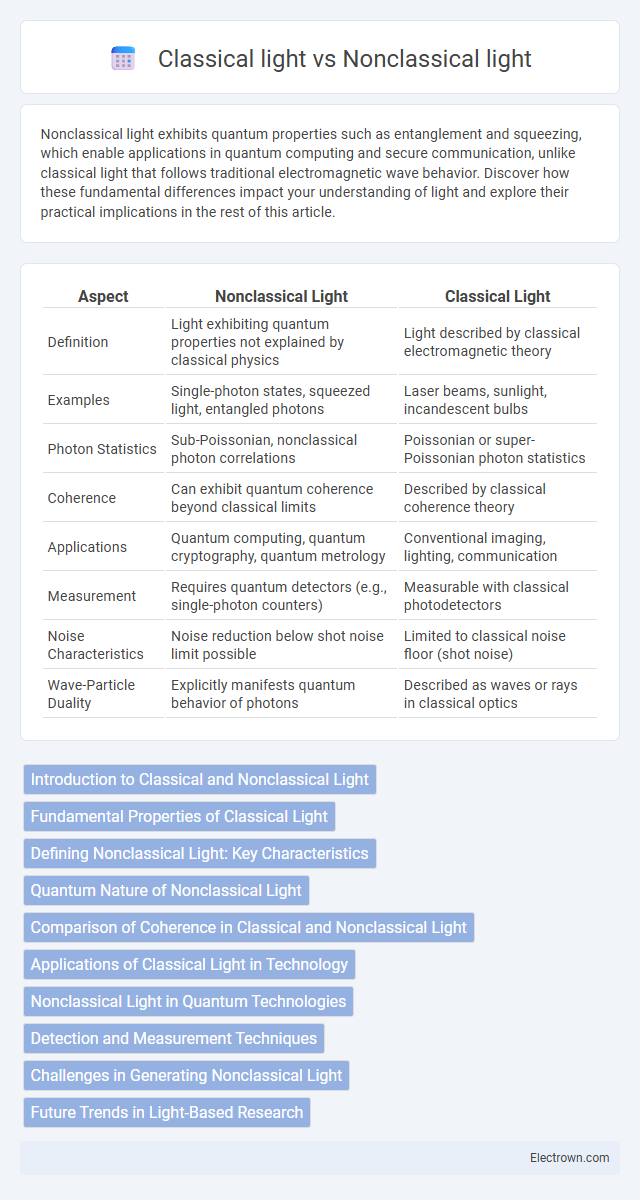Nonclassical light exhibits quantum properties such as entanglement and squeezing, which enable applications in quantum computing and secure communication, unlike classical light that follows traditional electromagnetic wave behavior. Discover how these fundamental differences impact your understanding of light and explore their practical implications in the rest of this article.
Table of Comparison
| Aspect | Nonclassical Light | Classical Light |
|---|---|---|
| Definition | Light exhibiting quantum properties not explained by classical physics | Light described by classical electromagnetic theory |
| Examples | Single-photon states, squeezed light, entangled photons | Laser beams, sunlight, incandescent bulbs |
| Photon Statistics | Sub-Poissonian, nonclassical photon correlations | Poissonian or super-Poissonian photon statistics |
| Coherence | Can exhibit quantum coherence beyond classical limits | Described by classical coherence theory |
| Applications | Quantum computing, quantum cryptography, quantum metrology | Conventional imaging, lighting, communication |
| Measurement | Requires quantum detectors (e.g., single-photon counters) | Measurable with classical photodetectors |
| Noise Characteristics | Noise reduction below shot noise limit possible | Limited to classical noise floor (shot noise) |
| Wave-Particle Duality | Explicitly manifests quantum behavior of photons | Described as waves or rays in classical optics |
Introduction to Classical and Nonclassical Light
Classical light is typically characterized by coherent or incoherent electromagnetic waves described by Maxwell's equations, exhibiting properties such as intensity, phase, and polarization. Nonclassical light, exemplified by single-photon states, squeezed states, and entangled photon pairs, defies classical descriptions and requires quantum optics frameworks like quantum electrodynamics for accurate representation. These nonclassical states enable applications in quantum communication, quantum computing, and high-precision metrology due to their unique statistical and correlation properties.
Fundamental Properties of Classical Light
Classical light is characterized by properties such as coherence, polarization, and intensity, described effectively by Maxwell's equations and classical electromagnetic theory. It exhibits predictable wave-like behavior, with intensity fluctuations governed by Poissonian or super-Poissonian statistics, reflecting classical noise levels. The phase and amplitude of classical light fields can be measured simultaneously with arbitrary precision, differentiating it clearly from nonclassical light exhibiting quantum effects like squeezing or photon antibunching.
Defining Nonclassical Light: Key Characteristics
Nonclassical light exhibits quantum properties that classical light lacks, such as antibunching, squeezing, and entanglement, which enable enhanced precision in measurements and secure quantum communication. Its photon statistics deviate from the Poisson distribution typical of classical light, often showing sub-Poissonian behavior indicative of reduced noise levels. Understanding these key characteristics allows you to harness nonclassical light in cutting-edge technologies like quantum cryptography and advanced imaging systems.
Quantum Nature of Nonclassical Light
Nonclassical light exhibits quantum properties such as squeezing, entanglement, and photon antibunching, which cannot be explained by classical electromagnetic wave theory. This quantum nature allows nonclassical light to have reduced noise below the shot-noise limit, enabling applications in quantum communication, precision metrology, and quantum computing. Classical light, described by coherent or thermal states, lacks these quantum features and follows classical statistics, limiting its performance in advanced quantum technologies.
Comparison of Coherence in Classical and Nonclassical Light
Classical light exhibits first-order coherence, characterized by predictable phase relationships and intensity correlations described by classical electromagnetic theory. Nonclassical light, such as single-photon or squeezed states, demonstrates higher-order coherence properties that cannot be explained by classical models, revealing quantum correlations and entanglement. These distinct coherence features enable advanced applications in quantum communication, metrology, and imaging beyond classical limits.
Applications of Classical Light in Technology
Classical light, characterized by predictable wave and particle properties, plays a crucial role in numerous technologies such as laser cutting, optical communication, and imaging systems. Its coherent and monochromatic nature enables high-precision tasks in industries including manufacturing, telecommunications, and medical diagnostics. Photon-based technologies leveraging classical light sources optimize data transmission rates and enhance holographic displays for advanced visualization.
Nonclassical Light in Quantum Technologies
Nonclassical light exhibits quantum properties such as entanglement, squeezing, and antibunching that classical light lacks, enabling breakthroughs in quantum technologies. Its unique characteristics enhance quantum communication, computation, and precision measurement by reducing noise and increasing information capacity beyond classical limits. Utilizing nonclassical light allows you to harness quantum effects for developing secure quantum networks and advanced quantum sensors.
Detection and Measurement Techniques
Nonclassical light, such as single-photon sources or squeezed states, requires advanced detection techniques like photon-counting detectors and homodyne or heterodyne measurements to accurately capture quantum properties. Classical light detection typically relies on photodiodes and power meters that measure intensity or phase without resolving individual photons. Quantum tomography and correlation function analysis are essential tools for characterizing nonclassical light's distinct statistical and coherence features compared to classical light.
Challenges in Generating Nonclassical Light
Generating nonclassical light involves overcoming significant challenges such as maintaining quantum coherence and minimizing decoherence caused by environmental noise and photon loss. Precise control over photon sources, including single-photon emitters and nonlinear optical processes, is essential to produce states like squeezed light or entangled photons. Ensuring stability and efficiency in your experimental setup requires advanced technologies to manipulate and detect fragile quantum states without compromising their nonclassical properties.
Future Trends in Light-Based Research
Advancements in nonclassical light, such as entangled photons and squeezed states, are driving breakthroughs in quantum computing, secure communication, and high-precision metrology. Classical light remains essential for traditional imaging and spectroscopy, but emerging technologies increasingly rely on nonclassical sources to surpass classical limits in sensitivity and resolution. Your exploration of future light-based research will benefit from focusing on hybrid systems that integrate classical and nonclassical light for enhanced performance in various scientific and technological applications.
nonclassical light vs classical light Infographic

 electrown.com
electrown.com